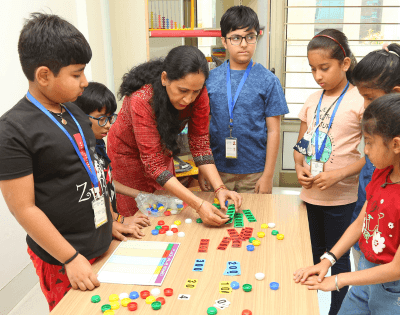Curiosity is a driver among the strongest for young people in learning and development. Quite often, when being a parent, you face your child asking many questions about everything that happens around him or her, and such curiosity will elicit both cognitive growth and emotional well-being.
It might explain why certain theories, like “self-determined curiosity” by Edward Deci and Richard Ryan, lean toward intrinsic drive as the driving force in making a person deeply study something and feel more satisfied.
Supporting curiosity in children involves incorporating simple strategies into daily life. It is by encouraging their questions, building a love for reading, and turning even mundane tasks into an opportunity for exploration that you nurture this inborn drive within them.
In this blog, we will cover 10 simple ways of developing curiosity in kids. These are some of the ways tested by our educators at The Blue Bells School and proven effective.
- Encourage Questions
Children are innately inquisitive. Instead of dismissing their questions, welcome them. Any question is an opportunity to learn something new. When your child asks you, “Why is the sky blue?” resist giving a straightforward answer. Engage them in a discussion or investigate the answer together. This satiates their curiosity and allows them to model behaviour in searching for information.

- Instill Love for Reading
Books are windows to different worlds and ideas. Provide a reading-friendly environment with a wide range of books available. Let the child choose his or her reading material, wherever his or her interest may lie. Be it stories of far-off planets or lands across the world, reading opens up their horizons and triggers new questions.

- Explore Together
Use daily activities as learning opportunities. The trip to the park, a walk in the neighbourhood, and even a visit to the grocery store might turn into an adventure. Point out and ask questions: “What do you think these plants need to grow?” or “Why do you think that fruit looks different than those?” Exploring together reinforces curiosity in children and shows them how to observe and think critically.
- Facilitate Open-Ended Play
Curiosity feeds on creative play. Provide your child with open-ended toys, such as block building, art supplies, or clothes for dressing up, and challenge them to create scenarios, solve problems, and work through unknowns. The more they are forced to think outside the box and test what has never been done before, the better.

- Model Curiosity
Children learn through example. Show your child the wonder you feel about the world. Ask questions about things you do not know and, through research, discover the answers. Share what you learn with your child. That way, the idea can be implanted in their head that learning is a lifelong process and that it is permissible to be less than perfect.
- Offer a Safe Play Environment
Let your child try new things; do not stop them from experimenting because of the possibility of committing mistakes. Ask the child to try new things; maybe a different recipe in the kitchen or taking part in a new hobby. Allow the child to understand that failures are part of the learning process. Support their endeavors and compliment their efforts, regardless of failure or success.
- Provide Diverse Experiences
Engage in your child’s favourite activities to encourage curiosity. This can be achieved by visiting museums, attending workshops, or engaging them in several types of sports. These varied experiences can help your child find out what will really excites them and inspire new areas of curiosity.
- Stimulate Reflection
Make sure your child reflects on his or her experience after learning something. Ask questions like “What do you think you have fun doing in this activity?” or “What did you learn today?” All the reflection will help them process their experience and consolidate what they learned.

- Remain Calm and Supportive
It is bound to be normal that children get frustrated or disappointed when they have faced obstacles. So, when your child undergoes frustration and disappointment in handling his/her plight, keep calm and composed. Be there with your child and tell them it’s all right to get worried sometimes and that facing some kinds of problems in life is what makes them learn. Your emotional support makes him or her want to learn and remain curious.
- Create a Curiosity-Friendly Space
Design a space in your home where the child can freely allow exploration of their interests. This might be a tiny science lab, an art corner, or perhaps it’s just a cosy nook for reading. A designated exploration space means that curiosity can be an exciting, accessible part of their daily lives.
Emotional Growth Support
Encouraging curiosity goes hand in hand with encouraging emotional growth in your child. Have patience and understanding toward the thought processes of your child and guide them through the course of navigating their emotions. Acknowledge their feelings, comfort them, and help them solve their problem. Your calm and supporting attitude will build their resilience and encourage them toward a healthy and curious way of life.




